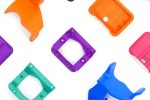
Shapeways Expands 3D Printing Capabilities
3dprintingindustry.com
Shapeways, a digital manufacturing service provider known for its breadth of 3D printing technologies and materials, has expanded its capabilities to include Fused Deposition Modeling (FDM). Alongside this new addition, the company has also restructured pricing for its Multi Jet Fusion (MJF) and Selective Laser Sintering (SLS) offerings and reinstated self-serve ordering for cast metal parts. These three changes collectively enhance accessibility and operational efficiency across Shapeways platform, particularly for clients seeking cost-effective prototyping, tooling, and small-batch production options.Thermoplastics now available through new FDM offeringFDM, a filament-based additive manufacturing process, extrudes heated thermoplastic material through a nozzle to build parts layer by layer. It is widely used for its affordability, accessibility, and ability to produce durable components with functional geometries. Shapeways now offers FDM parts in acrylonitrile butadiene styrene (ABS), acrylonitrile styrene acrylate (ASA), polycarbonate (PC), polyethylene terephthalate (PET), and polyethylene terephthalate glycol (PETG).ABS is known for its toughness and impact resistance, often used in functional prototypes and final parts requiring mechanical performance. ASA has similar structural properties but features increased resistance to ultraviolet light, enabling outdoor use. Polycarbonate offers high strength and thermal resistance, making it appropriate for engineering applications where parts may experience elevated temperatures or mechanical stress. PET is classified as food-safe and is frequently used for packaging mockups or prototypes of consumer goods. PETG, a modified version of PET, provides chemical resistance and improved printability, which is valuable for parts used in environments involving cleaning agents, alcohols, or food contact.By integrating FDM, Shapeways expands its reach into early-stage design validation, tool development, and short-run production. Shapeways has published an FDM page listing available materials and capabilities, with additional colors and polymers reportedly available upon request.Plastic 3D printed parts. Photo via Shapeways.Revised pricing structure for MJF and SLS follows process optimizationShapeways has updated its cost model for powder-based 3D printing technologies, reducing the price of both MJF and SLS production. This adjustment follows internal changes to its operating procedures, which, according to the company, have resulted in increased manufacturing efficiency. In the last couple of months we have been able to make some tweaks to our operations around our MJF and SLS processes that have resulted in greater efficiency, the company stated.SLS uses a high-powered laser to selectively fuse nylon-based powder, producing parts without the need for support structures. It is widely used in aerospace, healthcare, and automotive sectors due to its reliability and material performance. MJF, by contrast, uses an inkjet array to deposit fusing and detailing agents across a powder bed, then applies heat to solidify each layer. While both processes create functional, end-use parts, MJF tends to offer higher print speeds, better surface finish, and greater feature resolution, while SLS supports a broader range of polymers and is compatible with more established industrial workflows.Shapeways has made its new pricing model for both technologies publicly accessible, allowing prospective users to explore current cost structures through the companys online platform.Cast metal parts including bronze, silver, copper, and gold. Photo via Shapeways.Self-serve cast metal returns with instant quotes and expanded material optionsFinally, self-serve access to cast metal parts has been reinstated on Shapeways platform. The feature enables direct online quoting and ordering for eight metals: brass, bronze, silver, copper, yellow gold, white gold, rose gold, and vermeil. Finishes and karat values can be configured as part of the order.Parts are produced using lost-wax investment casting, initiated by 3D printing a wax model from the digital file. This model is encased in plaster, fired in a kiln to remove the wax, and filled with molten metal. Once cooled, the mold is broken and the part is polished or plated as specified.This process supports detailed geometries and is commonly used in jewelry, art, and small-scale mechanical production. More information on available cast materials and ordering procedures is provided via the companys sales email, which remains active for consultation beyond the self-serve interface.Dyed MJF and SLS parts. Photo via Shapeways.Ready to discover who won the 2024 3D Printing Industry Awards?Subscribe to the 3D Printing Industry newsletter to stay updated with the latest news and insights.Featured image showcase dyed MJF and SLS parts showcasing improved pricing and finish options. Photo via Shapeways.Anyer Tenorio LaraAnyer Tenorio Lara is an emerging tech journalist passionate about uncovering the latest advances in technology and innovation. With a sharp eye for detail and a talent for storytelling, Anyer has quickly made a name for himself in the tech community. Anyer's articles aim to make complex subjects accessible and engaging for a broad audience. In addition to his writing, Anyer enjoys participating in industry events and discussions, eager to learn and share knowledge in the dynamic world of technology.
0 Comments
·0 Shares
·37 Views


